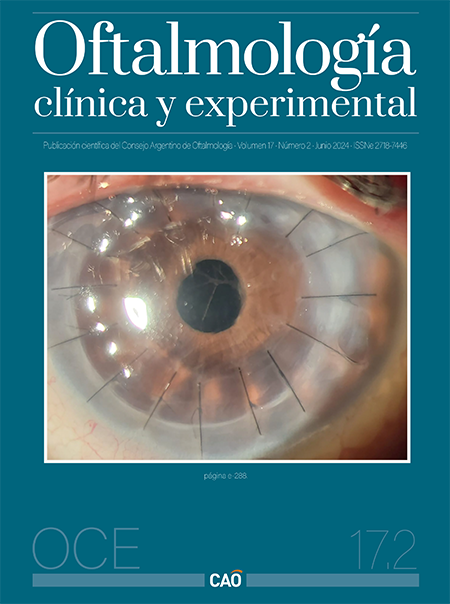Leaky ocular surface syndrome
DOI:
https://doi.org/10.70313/2718.7446.v17.n02.319Keywords:
ocular surface, allergy, dry eye, gut-ocular surface axis, leaky ocular surface, leaky conjunctiva, leaky gutAbstract
It has long been recognized that intestinal permeability is altered when the tight junctions between epithelial cells do not properly regulate the transcellular transport of macromolecules and can cause an interaction between the antigens of the microorganisms that inhabit the intestinal lumen and the host immune system. This loss of the intestinal barrier function increases its permeability and can trigger inflammatory, autoimmune and even tumor phenomena. Genetic factors, climate, diet, acute and chronic stress, socioeconomic conditions and habits and microbiota are linked to this alteration. Different authors point out the increase in intestinal permeability and its impact on the lungs, skin and brain, motivating the description of the intestine-lung, intestine-skin and intestine-brain axes. Following this descriptive line, we postulate our personal hypothesis on the possible manifestation of a gut-ocular surface axis. In the same way, and given that both the intestine and the conjunctiva are mucous membranes with epithelial barriers, we propose the potential for the ocular surface (mainly at the expense of the conjunctiva) to behave like the intestine, and upon loss of its permeability it could trigger the aforementioned inflammatory, autoimmune and tumor phenomena.
Downloads
References
Fasano A, Not T, Wang W et al. Zonulin, a newly discovered modulator of intestinal permeability and its expresion in coeliac disease. Lancet 2000; 355: 1518-1519.
Fasano A. Zonulin and its regulation of intestinal barrier function: the biological door to inflammation, autoimmunity, and cancer. Physiol Rev 2011; 91: 151-175.
Camilleri M. Leaky gut: mechanisms, measurement and clinical implications in humans. Gut 2019; 68: 1516-1526.
Wang L, Cai Y, Garssen J et al. The bidirectional gut-lung axis in chronic obstructive pulmonary disease. Am J Respir Crit Care Med 2023; 207: 1145-1160.
Yokoi K, Yokoi N, Kinoshita S. Impairment of ocular surface epithelium barrier function in patients with atopic dermatitis. Br J Ophthalmol 1998; 82: 797-800.
Wang Q, Yang Q, Liu X. The microbiota-gut-brain axis and neurodevelopmental disorders. Protein Cell 2023; 14: 762-775.
Singh N, Diebold Y, Sahu SK, Leonardi A. Epithelial barrier dysfunction in ocular allergy. Allergy 2022; 77: 1360-1372.
Martínez-Carrasco R, Argüeso P, Fini ME. Membrane-associated mucins of the human ocular surface in health and disease. Ocul Surf 2021; 21: 313-330.
Mantelli F, Mauris J, Argüeso P. The ocular surface epithelial barrier and other mechanisms of mucosal protection: from allergy to infectious diseases. Curr Opin Allergy Clin Immunol 2013; 13: 563-568.
Yoshida Y, Ban Y, Kinoshita S. Tight junction transmembrane protein claudin subtype expression and distribution in human corneal and conjunctival epithelium. Invest Ophthalmol Vis Sci 2009; 50: 2103-2108.
Leong YY, Tong L. Barrier function in the ocular surface: from conventional paradigms to new opportunities. Ocul Surf 2015; 13: 103-109.
Horai R, Caspi RR. Microbiome and autoimmune uveitis. Front Immunol 2019; 10: 232.
Moon J, Choi SH, Yoon CH, Kim MK. Gut dysbiosis is prevailing in Sjogren’s syndrome and is related to dry eye severity. PLoS One 2020; 15: e0229029.
Muravchik J. El microbioma y el ojo: ¿es posible una oftalmología sistémica? Oftalmol Clin Exp 2023; 16: e222-e232.
Aguilar A, Berra A. Hyperosmolarity of the tear film in the dry eye. En: Kopacz O (ed.). Ocular surface diseases: some current date on tear film problem and keratoconic diagnosis. London: IntechOpens, 2020. Disponible en: https://www.intechopen.com/chapters/70037
Portal C, Gouyer V, Gottrand F, Desseyn JL. Ocular mucins in dry eye disease. Exp Eye Res 2019; 186: 107724.
Perez VL, Stern ME, Pflugfelder SC. Inflammatory basis for dry eye disease flares. Exp Eye Res 2020; 201: 108294.
Baudouin C, Rolando M, Benitez Del Castillo JM et al. Reconsidering the central role of mucins in dry eye and ocular surface diseases. Prog Retin Eye Res 2019; 71: 68-87.
Yokoi K, Yokoi N, Kinoshita S. Impairment of ocular surface epithelium barrier function in patients with atopic dermatitis. Br J Ophthalmol 1998; 82: 797-800.
Jung SJ, Mehta JS, Tong L. Effects of environment pollution on the ocular surface. Ocul Surf 2018; 16: 198-205.
Leonardi A, Lanier B. Urban eye allergy syndrome: a new clinical entity? Curr Med Res Opin 2008; 24: 2295-2302.
Torricelli AA, Matsuda M, Novaes P et al. Effects of ambient levels of traffic-derived air pollution on the ocular surface: analysis of symptoms, conjunctival goblet cell count and mucin 5AC gene expression. Environ Res 2014; 131: 59-63.
Lasagni Vitar RM, Tau J, Janezic NS et al. Diesel exhaust particles (DEP) induce an early redox imbalance followed by an IL-6 mediated inflammatory response on human conjunctival epithelial cells. Exp Eye Res 2018; 171: 37-47.
Dogru M, Kojima T, Simsek C, Tsubota K. Potential role of oxidative stress in ocular surface inflammation and dry eye disease. Invest Opthalmol Vis Sci 2018; 59: DES163-DES168.
Mantelli F, Argüeso P. Functions of ocular surface mucins in health and disease. Curr Opin Allergy Clin Immunol 2008; 8: 477-483.
Gipson IK. Distribution of mucins at the ocular surface. Exp Eye Res 2004; 78: 379-388.
Argüeso P, Guzman-Aranguez A, Mantelli F et al. Association of cell surface mucins with galectin-3 contributes to the ocular surface epithelial barrier. J Biol Chem 2009; 284: 23037-23045.
Kunert KS, Keane-Myers AM, Spurr-Michaud S et al. Alteration in goblet cell numbers and mucin gene expression in a mouse model of allergic conjunctivitis. Invest Ophthalmol Vis Sci 2001; 42: 2483-2489.
Galletti JG, de Paiva CS. Age-related changes in ocular mucosal tolerance: Lessons learned from gut and respiratory tract immunity. Immunology 2021; 164: 43-56.
Downloads
Published
Issue
Section
License
Copyright (c) 2024 Consejo Argentino de Oftalmología

This work is licensed under a Creative Commons Attribution-NonCommercial-NoDerivatives 4.0 International License.
Con esta licencia no se permite un uso comercial de la obra original, ni la generación de obras derivadas. Las licencias Creative Commons permiten a los autores compartir y liberar sus obras en forma legal y segura.







